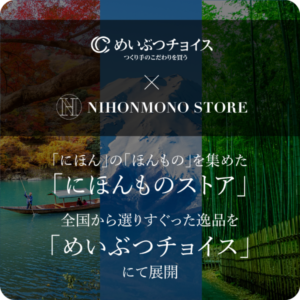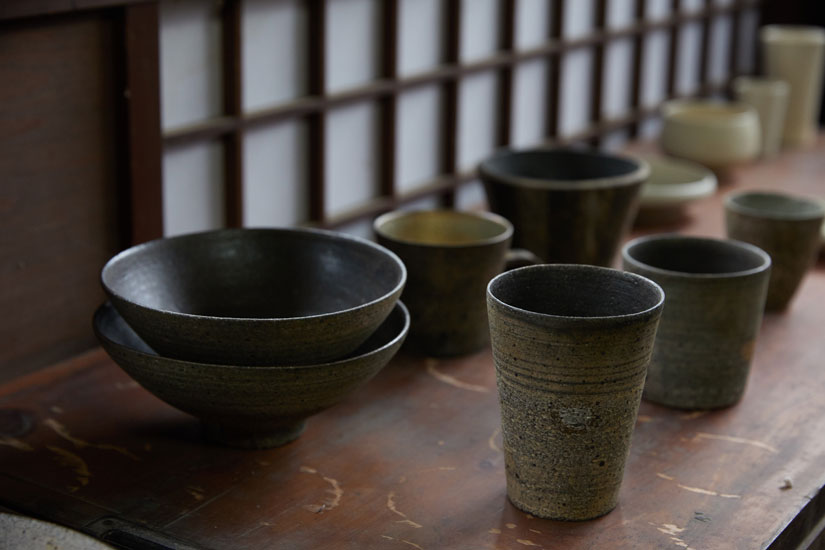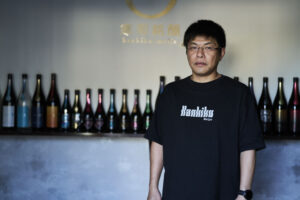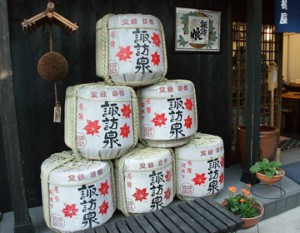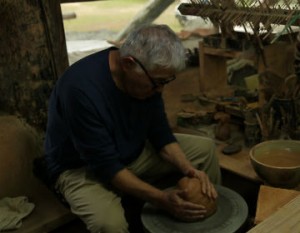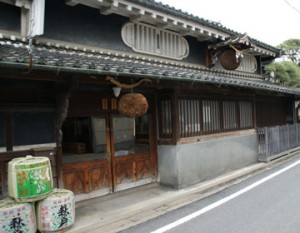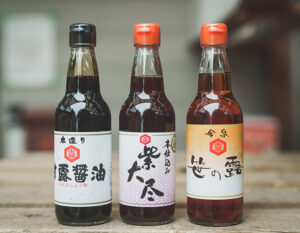Mashiko Town in Haga District, Tochigi Prefecture, is famous as the home of Mashiko ware. In a workshop nestled in the forest, potter Yuto Miyazawa devotes himself to his craft. Using his unique technique called “konjoute,” which deliberately leaves traces of the hands in the production process, he creates vessels that each have their own depth and rich expression.
Grew up watching his father, a potter, work from an early age.

Born and raised in Mashiko Town, Miyazawa-san is the son of potter Miyazawa Akira. Over 20 years ago, he began working in the studio his father built, dedicating himself to pottery.
From a young age, Miyazawa-san watched his father at work and developed an admiration for those who create things with their hands. Working with clay became a part of his daily life.
After graduating from high school in his hometown, he joined the art club and tried his hand at casting, which involves melting metal and pouring it into molds to create vessels and artworks. This experience sparked his desire to learn more about the joys of art. At the same time, he became more aware of his father’s presence as someone who was constantly engaged in the act of creating things. It was during this time that he also learned the processes and techniques of pottery from his father.
From metal casting to pottery
He attended Iwate University, where he found interest in the process of melting hard materials into shapes and the changes they undergo over time. During his first two years, he primarily focused on metal casting.
However, when it came time to choose a research laboratory to specialize in during his third year, Miyazawa opted for pottery.“The main reason was that I felt it would be difficult to make a living from metal casting.”
“Metal casting takes a lot of time, and I had the opportunity to hear about the world of southern ironware in Iwate, but it seemed very difficult… However, perhaps because I had seen my father up close, I imagined that I could make a living from pottery,” says Miyazawa.
From a young age, he had been exposed to pottery through his father, who was a potter, and had learned the basics and techniques of pottery-making since high school. This made the transition to pottery and the improvement of his skills relatively smooth.
During his studies, he won several pottery awards, giving him confidence that he could succeed. It seemed like his career as a potter was off to a smooth start.
Was this the beginning of a smooth sailing career as a potter?

Before graduating from university, he visited galleries in Tokyo and immediately held his first solo exhibition after graduation. The result was the harsh reality that “it might not be enough to make a living.”
While visiting galleries, he was asked by the owner of a famous gallery, “I find it odd that you can create such works at your age. Do you have connections within the industry?” When he mentioned his father, the owner replied, “Come back with your works after experiencing more of the world.”At the time, Miyazawa believed that technique alone was enough. He couldn’t understand the owner’s true meaning then, but those words still resonate strongly with him today.
The anguish of being “privileged”
After his first solo exhibition, Miyazawa began to think about what kind of works he wanted to create and how he wanted to make a living. He decided to borrow his father’s workshop and start creating there. “I felt that I was privileged,” he says.
However, that was precisely what caused his anguish.“I felt that I was working within a prepared framework. I felt that there was no substance to my work, and I began to struggle.”
Then, in 2011, the Great East Japan Earthquake struck.
A feeling of powerlessness. The pottery-making hands stopped
The Great East Japan Earthquake caused tremendous damage, mainly in the Tohoku region. Miyazawa’s town of Mashiko also experienced a magnitude 5 earthquake, and many pottery shops in the town were filled with piles of broken pottery, and many kilns collapsed.
As the entire country struggled to overcome this unprecedented disaster, Miyazawa was plagued by a sense of helplessness, thinking, “I can’t do anything. I can’t even help those around me.”
As he pondered these questions with no answers, he found himself spending more time worrying than creating.
It was Mr. Shunji Muroi, the 16th president (now chairman) of the hot spring inn “Daikokuya” in Itabashi Onsen, Nasu Shiobara City, who approached Miyazawa, who had come to a standstill.
He offered her a position as a staff member at the inn.
Daikokuya is a historic inn founded in 1551 during the Muromachi period, but it has gained attention as a hot spring inn with the keywords “recreation and art.” It houses the Kanae Sugaki Warehouse Museum, a private museum of contemporary artist Kanae Sugaki, and the garden was also designed by Sugaki.The inn regularly hosts solo exhibitions by various artists, photographers, and other creators, offering a unique blend of rich nature, hot springs, and art—a hidden gem known only to those in the know.
Miyazawa’s father, Akira, is also a potter who has held solo exhibitions at Ooguroya, and it was through this connection that he was introduced to the inn.
Miyazawa, who was no longer able to work with pottery, gratefully accepted the offer and decided to take the job.
A turning point in his life. Instead of becoming a potter, he chose to work at a traditional hot spring inn.

At Daikokuya, Miyazawa worked as a staff member at a hot spring inn rather than as a potter, and during those four years, he did not create a single piece of pottery. Miyazawa says he did not even feel the urge to create pottery, but rather, keeping a distance from pottery allowed him to rediscover the “interesting nature of pottery.”
“Every month, various artists, photographers, sculptors, and other artists would come to hold solo exhibitions, and seeing their works was very inspiring.Interacting with people was always fresh and enjoyable.“
By coming into contact with things that were different from his own genre, he was able to reexamine where his sense of ”what he likes“ came from.
A new start and a new step forward
He had originally planned to work at Daikokuya for three years. The president at the time told him, ”After three years, do what you want to do.”Due to staffing issues, he extended his stay by one year, making it four years, but Miyazawa eventually reached his “graduation.”
There was no trace of the Miyazawa who had been consumed by a whirlpool of muddy worries. “I was excited to see what would come out of me from now on.”
Through new experiences and encounters with people, Miyazawa took a significant step forward.
What is it that I truly want to do?

The first thing Miyazawa did after leaving Daikokuya was to “erase his father.” Until then, Miyazawa’s style had been influenced by his father, Akira’s, techniques. Akira created pottery using a unique technique called “sekka zogan,” which involves hand-building clay, firing it, and then peeling off the surface to polish it.
“I used white clay to create plain, unadorned pieces. By making something devoid of flavor, I wanted to erase my father and discover what I couldn’t compromise on.” After continuing this process for about two years and spending time confronting himself, he naturally began to approach his father’s techniques.
Miyazawa uses a potter’s wheel, applies glaze made from clay ash, and fires the pieces at 1,270 degrees Celsius. After removing them from the kiln, he roughens the surface with a coarse file. This manual process gives each piece a unique texture, revealing the depth of the natural clay and creating a warm yet wild, one-of-a-kind finish.
The pieces he creates are primarily everyday utensils. “Utensils are like empty frames; once they’re made, you can use them however you like. You can even turn them upside down—that’s what I find so appealing,” he says, expressing his fascination with the wide range of expressions possible through utensils.
Ambiguity and imperfection are also intentionally incorporated into his works.

Miyazawa says that she is still exploring what kind of works she wants to create in the future. Behind this is her fascination with ambiguous and empty things, and her desire to always remain ambiguous and in flux.
However, she also feels a contradiction in setting this as something she “wants to do,” as it becomes too strong and loses its emptiness.
Therefore, she wants to keep changing and continue searching for her own unique style.
“At first, I thought pottery was just about technique, but I’ve come to realize that it reflects one’s way of life,” says Miyazawa. The words of a gallery owner in Tokyo, who told her, “See more of the world,” just before she graduated from university, may have held this meaning.
“When working alone, it becomes too closed off, so I want to create situations where I can engage with people and things, and I want to keep that flexibility and space to do so.”
Miyazawa speaks with a casual smile, showing no signs of clinging to anything. She is calm and flexible, yet possesses a strong core and composure. She is not indecisive. Her deep thoughts and feelings, which embrace ambiguity and fluctuation, seem to be reflected in the expressive forms of her vessels.
Where Miyazawa will end up in the future is still unknown. That is precisely why she is so captivating.
